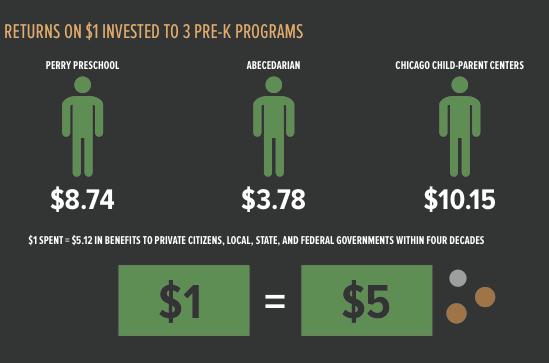We continue our Why Child Care Matters series with this third installment written by guest blogger, Sarah Swihart. Child care can present a huge barrier for parents working to provide for their families and an obstacle that does not often receive much attention. In this series, we hope to shed more light on this issue and make connections between child care and homelessness. This particular post examines the value of early learning and how that connects to child care.
Written by Sarah Swihart, MPA candidate at Seattle University.
By age five children should understand opposites, count 5-10 objects, speak in sentences, name colors, get along with others, and sit at their desk. Unfortunately, students living in poverty are more likely to start school without these basic skills. If children start behind they are more likely to stay behind. They are more likely to need special education, repeat a grade, and drop out of high school. Research demonstrates that high-quality pre-k increases a child’s chances of succeeding in school and in life. Early learning programs are essential if we want to end the cycle of poverty in our nation.
With school beginning soon, there a lot of families scrambling to find the money to purchase school supplies and teachers are frantically preparing for the upcoming school year. Summer can be and is a great time for many families, but for those in poverty it is often a barrier and a source of extreme anxiety and frustration. For some kids summer is full of day camps for three months where they learn how to sail, paint, and visit museums, but for a large majority of children summer is spent idly with little educational opportunities.

All children lose some knowledge they gained during their last school year, but it’s no surprise that low-income students lose up to two-three months of grade level equivalency in math and reading and more than half of the achievement gap between lower and higher income youth can be explained by unequal access to summer learning opportunities.
I mentioned before that I had the unique opportunity through my AmeriCorps experience in Federal Way, WA to tutor students from K-12th grade for three years. I had many of the same students throughout those three years and what I noticed from my kindergarten students was their inability to do some of things mentioned above. These students started behind and when they entered the classroom on their first day, they soon realized it and so did their teacher.
The struggling student soon begins to understand during those first few precious weeks of kindergarten that they can’t raise their hand as confidently as some of their other classmates, they can’t recite colors, count to 10, or play rhyming games. Their confidence begins to diminish and their love for learning begins to fade. These precious five year olds begin their first of thirteen years terrified, humiliated, and angry. It’s really no surprise when I read studies that have demonstrated when low-income students start behind they are more likely to drop out of high school, rely on social welfare programs, repeat a grade, or enter prison.
- 88% of children who are poor readers in first grade will still be poor readers by fourth grade
- 74% of children who are poor readers in third grade remain poor readers when they start high school

Let’s not forget about the teachers who work hours beyond their scheduled work week to grade papers, spend extra time after school mentoring and tutoring students, manage crowded classrooms, while also living a life of their own. Thank you teachers and administrators! You are appreciated and applauded for your commitment to education! There is a lot of pressure placed on teachers to meet standards, but when students enter unprepared it’s difficult for them to start the year without spending time catching a lot of students up academically and socially.
- 46% of teachers feel that at least half of the children in their classes have difficulty following directions
- 36% feel that half the children have problems with academic skills
- 34% find that more than half of their children have difficulty working independently
With this ranting comes an important message-early learning programs and access to affordable child care are fundamental components to ending poverty and interrupting the hopelessness so many of our children and families face here in the United States.

Poverty is on the rise and with the cost of child care rivaling that of a college education; we can’t expect families who are struggling to make ends meet pay thousands of dollars to place their children in babysitting mills. This is where it can get tricky; we need to provide access to affordable quality child care while taking some of the financial burden off of the families shoulders. Child care providers don’t get paid much (which needs to change), and there is a lot of cost that comes with running a child care facility. So how do we improve child care facilities while also making it affordable for all families?
Next I’ll be attempting to answer this question. I’ll also investigate what programs are working, how early learning and child care programs translate into policy and the impact these have on ending the cycle of poverty and homelessness in our nation.
Some Great Early Learning Champions in Washington State: